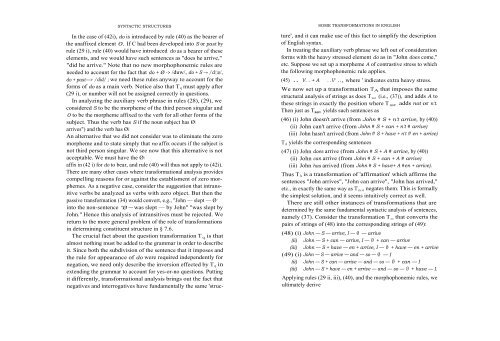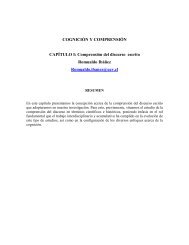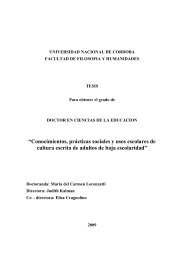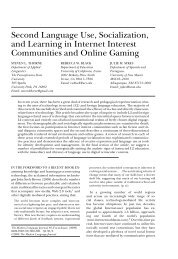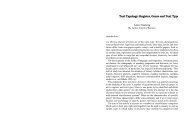Syntactic Structures
Syntactic Structures
Syntactic Structures
You also want an ePaper? Increase the reach of your titles
YUMPU automatically turns print PDFs into web optimized ePapers that Google loves.
SYNTACTIC STRUCTURES<br />
In the case of (42i), do is introduced by rule (40) as the bearer of<br />
the unaffixed element 0. If C had been developed into S or past by<br />
rule (29 i), rule (40) would have introduced do as a bearer of these<br />
elements, and we would have such sentences as "does he arrive,"<br />
"did he arrive." Note that no new morphophonemic rules are<br />
needed to account for the fact that do + Ø -> /duw/, do + S → /dəz/,<br />
do + past—> /did/ ; we need these rules anyway to account for the<br />
forms of do as a main verb. Notice also that T q must apply after<br />
(29 i), or number will not be assigned correctly in questions.<br />
In analyzing the auxiliary verb phrase in rules (28), (29), we<br />
considered S to be the morpheme of the third person singular and<br />
0 to be the morpheme affixed to the verb for all other forms of the<br />
subject. Thus the verb has S if the noun subject has Ø ("the boy<br />
arrives") and the verb has Ø if S("the the boys subject arrive"). has<br />
An alternative that we did not consider was to eliminate the zero<br />
morpheme and to state simply that no affix occurs if the subject is<br />
not third person singular. We see now that this alternative is not<br />
acceptable. We must have the Ø morpheme or there will be no<br />
affix in (42 i) for do to bear, and rule (40) will thus not apply to (42i).<br />
There are many other cases where transformational analysis provides<br />
compelling reasons for or against the establisment of zero morphemes.<br />
As a negative case, consider the suggestion that intransitive<br />
verbs be analyzed as verbs with zero object. But then the<br />
passive transformation (34) would convert, e.g., "John — slept — Ø "<br />
into the non-sentence "Ø — was slept — by John" "was slept by<br />
John." Hence this analysis of intransitives must be rejected. We<br />
return to the more general problem of the role of transformations<br />
in determining constituent structure in § 7.6.<br />
The crucial fact about the question transformation T q is that<br />
almost nothing must be added to the grammar in order to describe<br />
it. Since both the subdivision of the sentence that it imposes and<br />
the rule for appearance of do were required independently for<br />
negation, we need only describe the inversion effected by T q in<br />
extending the grammar to account for yes-or-no questions. Putting<br />
it differently, transformational analysis brings out the fact that<br />
negatives and interrogatives have fundamentally the same 'struc-<br />
SOME TRANSFORMATIONS IN ENGLISH<br />
ture', and it can make use of this fact to simplify the description<br />
of English syntax.<br />
In treating the auxiliary verb phrase we left out of consideration<br />
forms with the heavy stressed element do as in "John does come,"<br />
etc. Suppose we set up a morpheme A of contrastive stress to which<br />
the following morphophonemic rule applies.<br />
(45) .. V. . + A . .V' .., where ' indicates extra heavy stress.<br />
We now set up a transformation TA that imposes the same<br />
structural analysis of strings as does T not (i.e., (37)), and adds A to<br />
these strings in exactly the position where T not, adds not or n't.<br />
Then just as T not, yields such sentences as<br />
(46) (i) John doesn't arrive (from John # S + n't arrive, by (40))<br />
(ii) John can't arrive (from John # S + can + n't # arrive)<br />
(iii) John hasn't arrived (from John # S + have + n't # en + arrive)<br />
TA yields the corresponding sentences<br />
(47) (i) John does arrive (from John # S + A # arrive, by (40))<br />
(ii) John can arrive (from John # S + can + A # arrive)<br />
(iii) John has arrived (from John # S + have+ A #en + arrive).<br />
Thus TA is a transformation of 'affirmation' which affirms the<br />
sentences "John arrives", "John can arrive", "John has arrived,"<br />
etc., in exactly the same way as Tnot negates them. This is formally<br />
the simplest solution, and it seems intuitively correct as well.<br />
There are still other instances of transformations that are<br />
determined by the same fundamental syntactic analysis of sentences,<br />
namely (37). Consider the transformation T so that converts the<br />
pairs of strings of (48) into the corresponding strings of (49):<br />
(48) (i) John — S — arrive, I — Ø — arrive<br />
(ii) John — S + can — arrive, I — Ø + can — arrive<br />
(iii) John — S + have — en + arrive, I — Ø + have — en + arrive<br />
(49) (i) John — S — arrive — and — so — Ø — I<br />
(ii) John — S + can — arrive — and — so — Ø + can — I<br />
(iii) John — S + have — en + arrive — and — so — Ø + have — I.<br />
Applying rules (29 ii, iii), (40), and the morphophonemic rules, we<br />
ultimately derive


